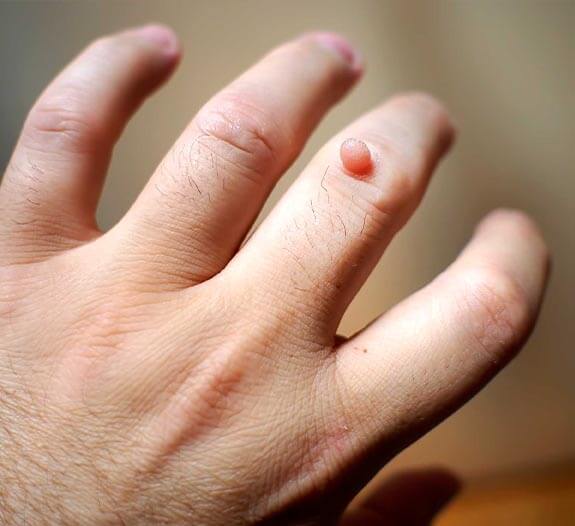
Types of Warts
Following are the main three different kinds of warts, including:
1. Common warts
Mostly grow on the fingers, around the nails and on the backs of the hands. In this type of warts, blood vessels produce black dots that appear as ‘seeds’, hence, common warts are also known as seeds.
2. Foot warts
As the name suggests these warts appear on the soles of the feet. This area is also known as plantar area, therefore, these warts are also commonly known as ‘plantar warts’. Sometimes, these warts appear in clusters which are then referred to as mosaic warts. These are hard and painful. So, it may feel like a stone in the shoe. These may also have seed-like black dots.
3. Flat warts
These are smaller than other types of warts yet grow in a large number at once. So, one may experience a sudden growth of 20-40 smooth warts at a time. They can occur anywhere but most common on the face, beard area and on the legs.
Treatments
If warts are bothersome, painful, or rapidly multiplying then they should be treated. Dermatologists are trained to use a variety of treatments, depending on the age of the patient and the type of wart. Following are the treatment option for warts:
1. Salicylic Acid Lotion
In some patients, warts can be treated at home by applying a salicylic acid solution. There may be little discomfort while applying the lotion and this method can take many weeks of treatment to obtain favorable results.
2. Cryotherapy
Cryotherapy (freezing) is generally preferred in adults and older patients and repeat treatments at two to three weeks intervals are often required.
3. Radiosurgery & Electrocautery
This is another good alternative treatment for warts. Laser (CO2) treatment can also be used for resistant warts that have not responded to other therapies.
4. Immunotherapy
This is another method of treatment for viral warts and there are attempts to use the body's own rejection system. In this method, the MMR vaccine can be used in dilution and injected on the wart. A mild allergic reaction occurs around the treated warts and may result in the disappearance of warts.
5. Other treatment options
Another treatment is to inject each wart with certain antimitotic drugs. This treatment option may be painful and can have other side effects.
Sometimes it seems as if new warts appear as fast as old ones go away. The best way to limit this is to treat new warts as quickly as they develop, so they have little time to shed virus into nearby skin. A regular check by a dermatologist can help to assure the treated wart has resolved completely.
 Whatsapp
Whatsapp Facebook
Facebook Twitter
Twitter Instagram
Instagram Linkedin
Linkedin Pinterest
Pinterest